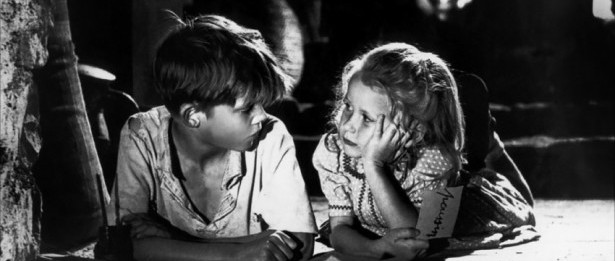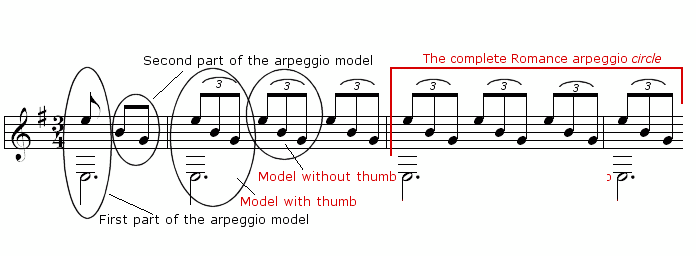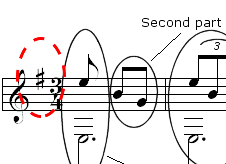
Anonim, "Romance" (TAB)
Transcription and Fingering: Renato Bellucci
Our first concert piece: Romance. A piece made famous by the Spanish guitarist Narciso Yepes who recorded it to become the soundtrack of a french movie "Forbidden games". It was the first great guitar classic launched by a movie.. the last one I can think of is Stanley Myer's Cavatina.
To play Romance, we will first focus on the right hand (the hand responsible for sound fabrication, literally). The right hand (from now on RH) will be playing an arpeggio.
Arpeggio = Playing the notes of a chord successively rather than simultaneously.
Use a guitar tuner to tune your guitar. You can always use your ears as backup.
Work on the model and get your RH oiled - To oil: Verb, to put oil into a machine to make it work more smoothly-. Do not play faster than necessary. You are playing too fast if you make mistakes. Nobody is hurrying you. Focus on sound and simply make sure that every string is projecting the sound you like. Practice this model 3 minutes at a time. Then rest and repeat for 3 more minutes. Do this a total of 3 times on your first practice session.
Key Signature Explained
Right next to the G clef at the beginning of the piece (image above), you sometimes have what are called "accidents" (sharps, flats). These would be the equivalent of the black keys on a piano. They indicate that the note that the sharp in this case points to, the F in Romance, and all the Fs throughout the first part of Romance will be sharpened. In other words, unless indicated otherwise, every time you find an F in the first part of Romance you play an F#. This is done so in order to tell the player what tonality (the musical equivalent of color tone to a painter) the piece is written in and to avoid cluttering the score with too many markings... If the sharp is an isolated occurrence, it will only affect the note it points to in the measure where it appears but then leaves the note unaltered in the next measure
The image above shows the key signature of the second part of Romance. This indicates that throughout the second part, all Fs, Cs, Gs and Ds will be sharpened unless otherwise indicated.
Staff and Video 6
Notice the change of key from E minor to E major. To the trained musician's ear, keys (tonalities) are like colors to a painter. Keys change the mood and break monotony. Take a deep, slow breath before the barre on fret 2. Incorporate breathing as part of the music. To breathe properly makes things easier and dissolves tension. As finger 4 is stopping the G# on string one (yellow arrow), it also anchors the hand in position and the hand stretches to reach the G# on string 3 stopped by finger 1 (yellow arrow). As you put the barre down, 2 fingers go down simultaneously indicated by the red arrows in the video: the F# on string 6 and the E on string 2 played with finger 4. Finger 4 slides to the D# with the participation of the palm of the hand. It is not the finger that slides but rather the hand that changes the position of finger 4 on the fingerboard.
Video 6
Staff and Video 7
The barre 7 above is very similar to barre 7 in part 1. Fingers 1 and 3 strop the B and C# a fraction of a second before finger 2 stops the D#. See how finger 4 is standing by to simply go down on the high D on string 1 when the music requires.
Fingers 1, 2 and 3 sop the B-C# and D simultaneously. Lift the fingers off the fingerboard n a perpendicular manner to minimize string squeaks.
Video 7
Staff and Video 8
Finger 4 goes down first, than finger 3 stopping the G# follows and finally finger 2 stopping the E on string 3 comes down. You can play the B on string 1 using the base of finger 1. As a guitarist you must see finger 1 has having 2 tips: one is the tip you always use and the other is located close to where the finger meets the palm of the hand. I refer to this technique as using "the base of 1".
One of the secrets of flawless playing is to maximize finger movements. That is the reason I chose to use the base of finger 1 for the B.
The base of finger 1 is pressing string 1. Follow the previous link for further explanations.

Video 8
Staff and video 9-A
You can use the following alternative fingering for staff 9, measures 2 and 3.
Breath to prepare the small barre 5. The challenge is to achieve the
stretch with relaxation. What this means s that you must learn how to
control tension during performance. Typically, as the challenges
augment, the player tends to become more tense and anxious. Pros learn
to do quite the opposite. As the challenge augments, an order is sent
from the brain to relax more. You must implement this technique early on
in your career.
Later, the left hand rotates to allow finger 1 to become a small 2 strings barre.
Video 9-A
Staff and Video 9 - B
I call this Donna's choice. It works perfectly instead of the Barre 2 with stretch in staff 10 measure 2.
Change finger 1 for a small barre 5. Use the arm to rotate the hand and lift finger 1 slightly upwards (curved)

Notice how finger 4 is substituted for finger 1. The arm participates.
There is a stretch with full participation of the forearm. (allow a few
seconds for the animation to load)
This is the end of the most
famous guitar piece in the universe. Romance format is often referred
to as AABBA (part 1 twice, part 2 twice and part 1 once).
Congratulations!
Video 9-B
Revision: Asunción, February 14, 2013
 Back to Top
Back to Top












